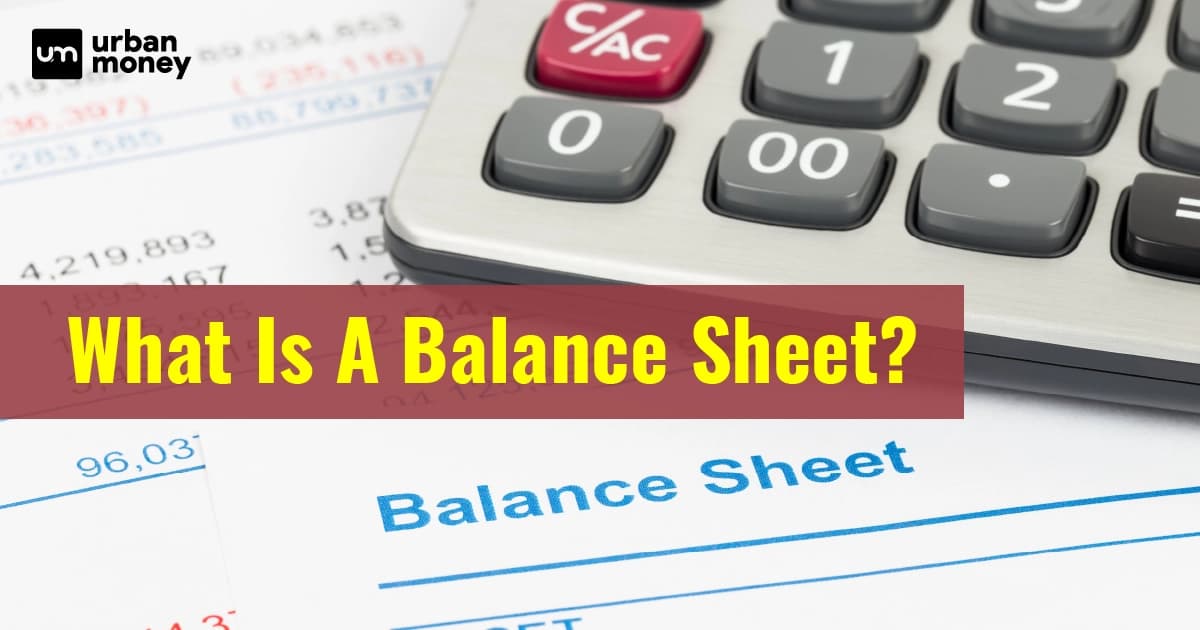What is a Bank Balance Sheet?

- Personalized solutions
- Expert guidance
- Application assistance
- Credit score discussion
- Interest rate comparison


Last Updated: 20 December 2025
A bank balance sheet is a summary of the bank’s financial situation at a given point in time. It shows what the bank owns (assets) and what it owes (liabilities) to others. It also shows how much money the bank has invested by its owners or shareholders (equity). The balance sheet must always balance, meaning the total assets must equal the total liabilities and equity. This is because every asset is funded by either a liability or equity, and every liability or equity is backed by an asset.
What Does a Bank Balance Sheet Include?
A bank’s balance sheet should include assets, liabilities, and equity. These three make up the major crux of a bank’s financial situation. The assets are the things the bank owns or has a right to receive. The liabilities are the things that the bank owes or should pay. Equity is the difference between the assets and liabilities. It represents the money the bank’s owners or shareholders have invested and can claim if it is liquidated. It also reflects the profits or losses that the bank has made over time.
Here’s an example of a small bank that has only four items on its balance sheet:
|
Assets |
Amount |
Liabilities |
Amount |
|
Cash |
100 |
Deposits |
800 |
|
Loans |
900 |
Borrowings |
100 |
|
Equity |
100 |
||
|
Total |
1000 |
Total |
1000 |
What Can You Do With a Bank’s Balance Sheet?
Some things you can do with a bank’s balance sheet are:
- Compare the bank’s assets and liabilities to see how well it manages its liquidity, solvency, and profitability.
- Look at the bank’s assets composition to see how diversified and risky its lending portfolio is. For example, you can check the proportion of loans, securities, cash, and other financial instruments on the asset side.
- Look at the bank’s liabilities composition to see how stable and costly its funding sources are. For example, you can check the proportion of deposits, borrowings, equity, and other financial instruments on the liability side.
- Calculate various ratios and indicators to measure the bank’s performance and efficiency. For example, you can calculate the return on assets (ROA), return on equity (ROE), net interest margin (NIM), loan-to-deposit ratio (LDR), capital adequacy ratio (CAR), and non-performing loan ratio (NPLR) using data from the balance sheet.
- Compare the bank’s balance sheet with its peers or industry averages to see how it performs relative to its competitors or benchmarks.
How to Read a Bank’s Balance Sheet?
To read a bank’s balance sheet, you need to understand its main components and how they relate. Here are some simple steps:
- Start with the assets section, which shows what the bank owns or controls. The assets are usually listed in order of liquidity, meaning how easily they can be converted to cash. The most liquid assets are cash and cash equivalents, such as short-term securities. The least liquid assets are fixed assets, such as buildings and equipment.
- Next, look at the liabilities section, which shows what the bank owes or has to pay. The liabilities are usually listed in order of maturity, meaning how soon they must be paid. The most current liabilities are deposits, which are the money that customers have entrusted to the bank. The least current liabilities are long-term debt, such as bonds and notes.
- Finally, look at the equity section, which shows the difference between the assets and liabilities. This is also known as the bank’s net worth or book value. The equity consists of two parts: the share capital, which is the money that shareholders have invested in the bank, and the retained earnings, which is the accumulated profit the bank has earned over time and reinvested in its business.
- To check if the balance sheet is balanced, add the total assets and compare it with the total liabilities and equity. They should be equal, meaning the bank’s resources match its obligations and ownership claims.
Banks Balance Sheet Example
Here is an example of a bank’s balance sheet.
|
Assets |
Amount INR |
Liabilities and Equity |
Amount INR |
|
Cash and cash equivalents |
10,000 |
Deposits |
80,000 |
|
Loans |
70,000 |
Borrowings |
10,000 |
|
Securities |
20,000 |
Other liabilities |
5,000 |
|
Other assets |
5,000 |
Share capital |
5,000 |
|
Total assets |
105,000 |
Retained earnings |
5,000 |
|
Total liabilities and equity |
105,000 |
Balance Sheet Assets
The asset section includes the following particulars.
Cash and cash equivalents: The bank has money in its vaults or in its accounts with the central bank or other banks. It is the most liquid asset, meaning it can pay for anything immediately.
Loans: This is the money the bank lent to its customers, such as individuals, businesses or governments. It is the main source of income for the bank, as it earns interest from the borrowers. However, it is also risky, as some borrowers may default or fail to repay their loans.
Securities: This is the money that the bank has invested in various financial instruments, such as bonds, stocks or derivatives. It is another way for the bank to earn income from interest or dividends, as well as to diversify its portfolio and manage its risk exposure.
Other assets: This is the money that the bank has in other forms, such as fixed assets (buildings, equipment, etc.), intangible assets (goodwill, trademarks, etc.) or prepaid expenses (rent, taxes, etc.).
Balance Sheet Liabilities
The liabilities section includes the following particulars.
Deposits: This is the money the bank owes to its customers who have deposited their funds. It is the main source of funding for the bank, as it pays interest to the depositors. However, it is also a liability, as the bank has to return the money on demand or at maturity.
Borrowings: This is the money that the bank owes to other banks or financial institutions, such as the central bank or interbank market. It is another way for the bank to obtain funding, especially when it faces a liquidity shortage or a high demand for loans. However, it is also a liability, as the bank must pay the lender’s interest and principal.
Other liabilities: This is the money that the bank owes in other forms, such as accrued expenses (wages, utilities, etc.), deferred income (fees, commissions, etc.) or provisions (contingent liabilities, loan losses, etc.).
Balance Sheet Equity
The balance sheet equity section can include the following particulars.
Share capital: This is the money the bank has received from its shareholders who have invested in its shares. It is a permanent source of funding for the bank, as it does not have to be repaid. However, it also claims the bank’s assets and profits, as the shareholders are entitled to dividends and voting rights.
Retained earnings: This is the money that the bank has accumulated from its past profits and reinvested in its business. It is a way for the bank to grow its equity and increase its value. However, it is also a claim on the bank’s assets and profits, representing the shareholders’ share of undistributed earnings.
Analysing Bank Balance Sheets
To analyse a bank’s balance sheet, look at its assets, liabilities, and equity and how they relate. You must also consider key aspects affecting a bank’s financial position, such as risk management and liquidity analysis. By analysing a bank’s balance sheet, you can assess its financial health, performance and risk profile. However, you should also consider other factors affecting a bank’s financial position, such as macroeconomic conditions, competitive environment, regulatory changes, customer behaviour and expectations, etc.
Risk Management
This is how the bank manages its various risks, such as the risk of losing money due to borrowers not repaying their loans or due to changes in market prices or rates. You can use some ratios and indicators to measure these risks, such as the non-performing loan ratio, the capital adequacy ratio, the loan-to-deposit ratio, the net interest margin and the return on assets.
Liquidity Analysis
This is how the bank can meet its short-term and long-term cash needs and obligations. Liquidity is important for a bank to operate smoothly and avoid insolvency or distress. You can use some ratios and indicators to measure liquidity, such as the cash and cash equivalents, the current ratio, the quick ratio and the cash flow statement.
Important Indicators in Bank’s Balance Sheet Analysis
Some important indicators in a bank’s balance sheet analysis are given below. Using these indicators, you can analyse a bank’s balance sheet and assess its financial health, performance and risk profile. However, you should also consider other factors affecting a bank’s financial position, such as macroeconomic conditions, competitive environment, regulatory changes, customer behaviour and expectations, etc. Therefore, a comprehensive and holistic analysis should consider quantitative and qualitative aspects of a bank’s business.
- Liquidity shows how well the bank can meet its short-term and long-term cash needs and obligations.
- Solvency shows how well the bank can cover its debts and liabilities with its assets and equity.
- Profitability: This shows how well the bank can generate income and profit from its assets and equity.
Accounting Rules for Valuing Assets in a Bank
Accounting rules for valuing assets in a bank are the rules that tell how much the bank’s assets are worth. Assets are the things that the bank owns or controls, such as cash, loans, securities, buildings, etc. Valuing assets is important for preparing financial statements and measuring the bank’s performance and risk. To explain this simpler, imagine you have a bank account with INR 100 in it. That is an asset for you because you can use it to buy or save things for later. How do you value your asset? You can use different methods:
- Cost method: This is when the asset is valued at the price the bank pays. This is usually used for fixed assets, such as buildings and equipment, that do not change much in value over time.
- You can value your asset at INR 100 because that is how much money you put in your account. This is simple and easy, but it does not reflect changes in your money’s value over time.
- The market value method is used when the asset is valued at the price the bank can sell it for in the open market. This is usually used for current assets, such as cash and securities, that can be easily converted to cash.
- The fair value method is when the asset is valued at a price that reflects its current condition and future benefits. This is usually used for intangible assets, such as patents and trademarks, that have no physical form but can generate income for the bank.
Conclusion
It goes without saying that maintaining a balance sheet is an important part of financial management, and for good reasons. It shows the overall financial position of the entity. Furthermore, by analysing the sheet, one can understand how the bank generates income from its assets, funds its operations from its liabilities, and allocates its capital among different activities. Moreover, a balance sheet can also help investors, regulators, and other stakeholders assess its performance and stability compared to its peers and industry benchmarks. Lastly, it is not only a reflection of its past and present activities but also a guide for its future strategies and goals.
FAQ About Bank Balance Sheet
What are the 3 components of a bank balance sheet?
Assets, liabilities, and equity are the three components of a bank balance sheet.
How do you write a bank balance sheet?
The bank’s accounting department typically prepares a bank balance sheet and follows a standard format. It is divided into three main sections: assets, liabilities, and equity. Each section lists the relevant accounts and their balances. The sum of the liabilities and equity sections should equal the total assets.
What information does a bank balance sheet provide?
A bank balance sheet provides information about the bank’s assets, liabilities, and equity.
Why is the bank balance sheet crucial?
Because a balance sheet represents a bank’s financial health at a given time, it can be said to be crucial in nature. It shows a clear picture of what a bank owns and owes. Moreover, any additional investments made by any shareholders also reflects in the data shown. It also acts instrumental in fetching a conclusion regarding the bank’s financial situation.
How often is a bank balance sheet prepared?
A bank balance sheet is usually prepared at the end of a financial year (typically every 12 months on the last day of March or December), but it can be created at any or multiple points in time, say quarterly or half-yearly. Companies, especially publicly traded ones, prepare their balance sheet reports on a quarterly basis.
What are the main components of a bank balance sheet?
The main components of a bank balance sheet are assets, liabilities, and equity. Assets represent what a bank owns, including cash, securities purchased, loans, and financial instruments. Liabilities represent what a bank owes, including deposits, loan-loss reserves, and any debt it owes. Equity represents the owners’ stake in a bank and serves as a cushion for depositors and creditors to fall back in case of losses.
What is the difference between assets and liabilities on a bank balance sheet?
Assets and liabilities are the two main components of a bank balance sheet. Assets represent what a bank owns, whereas liabilities represent what a bank owes. The difference between a bank’s assets and liabilities represents the bank’s net worth or its equity value to investors.
What are some examples of assets on a bank balance sheet?
Some examples of assets on a bank balance sheet include cash, securities purchased, loans, and financial instruments. The asset portion of a bank’s capital includes cash, government securities, and interest-earning loans (e.g., mortgages, letters of credit, and inter-bank loans).
What are some examples of liabilities on a bank balance sheet?
Generally, particulars of the nature of payables are included in the liabilities section. These can be debts, loans, or accrued expenses. Some examples of liabilities on a bank balance sheet include deposits, loan-loss reserves, and any debt it owes.
How is capital represented on a bank balance sheet?
The capital is left when you deduct the bank’s liabilities from the bank’s assets. It shows the net assets of an entity and represents the owners’ stake in a bank, and it serves as a cushion for depositors and creditors to fall back in case of losses.
What is the purpose of categorising assets and liabilities on a bank balance sheet?
The purpose of categorising assets and liabilities on a bank balance sheet is to provide an overall summary of what a company owns and owes and the amount invested by shareholders at a specific time. Balance sheets provide the basis for computing rates of return for investors and evaluating a company’s capital structure.
